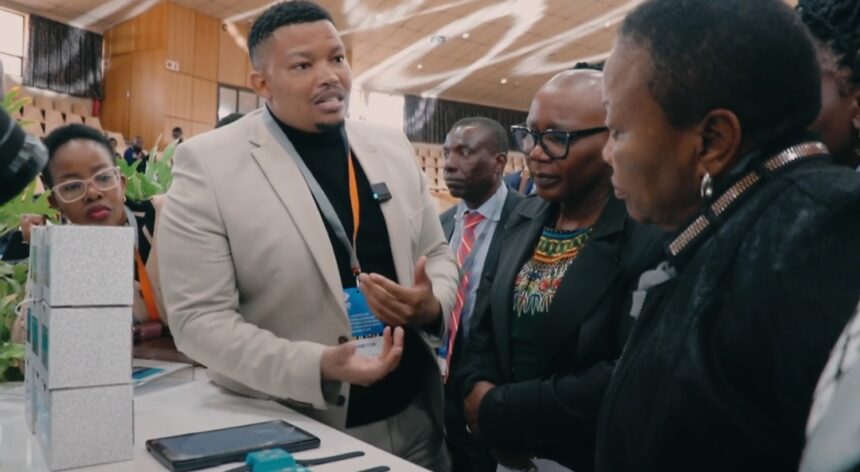South African startup Oplene Group is drawing international attention with KA-DAH, a new assistive device that allows people with visual impairments to use smartphones without touching the screen.
“Using hardware, software and audio feedback, the device makes it possible for users to scroll, open apps, make calls, and interact with digital services independently,” founder Tieho Tsiane explained.
Since its launch, more than 180 KA-DAH units have been deployed across South Africa’s Free State and Gauteng provinces, while Oplene has secured significant grant and accelerator funding to scale production and introduce advanced features such as artificial intelligence (AI) personalisation, speech-to-text integration, and secure financial transaction capabilities.
What KA-DAH Is
KA-DAH is a compact hardware-based tool designed to bridge the gap between smartphones and users who cannot rely on touchscreens.
Unlike traditional software-only screen readers or accessibility apps, KA-DAH integrates physical sensors with real-time voice commands, making it more intuitive and responsive.
Tsiane describes its mission as “to improve accessibility, independence, and inclusion for visually impaired people” at a price lower than many competing assistive devices, which can cost several hundred dollars, far beyond the reach of many South Africans.
How It Works
The device combines three core elements; specialised hardware sensors, custom-built software, and clear audio feedback. Users navigate smartphone menus, open apps, and make calls using simple gestures or spoken commands.
KA-DAH responds instantly with voice prompts, creating a seamless, touch-free experience.
While screen readers can be slow or complex, KA-DAH’s real-time gesture and voice integration allows faster, more natural interactions, removing many frustrations that blind or partially sighted users face.
Background: How KA-DAH Came In
Oplene Group was founded in 2018 after Tsiane observed how friends with visual impairments struggled with everyday smartphone tasks.
Determined to create a simpler solution, he developed early prototypes and tested them in the Free State towns of Hennenman and Sasolburg.
“We listened closely to testers’ feedback and kept refining the device,” Tsiane recalls.
Over several years and multiple iterations, the KA-DAH evolved into a reliable, user-friendly product that testers describe as easier and more empowering than existing tools.
The Business Side of KA-DAH
Revenue currently comes from direct sales to individuals, NGOs, schools, and government agencies, as well as pilot deployments.
Oplene is also planning a subscription model, offering monthly or annual packages for premium features like cloud-based support, AI-driven personalization, advanced voice commands, and continuous software updates.
“Profits are being reinvested into product development, user support, and scaling production,” Tsiane said, adding that early grants and accelerator programs have been crucial for growth.
Future Plans and Expansion
The company’s first major goal is a nationwide rollout across South Africa, working with NGOs, schools, and the Department of Social Development to reach communities where smartphone accessibility is limited.
Phase two targets Southern African Development Community (SADC) countries with similar accessibility gaps, including Botswana, Namibia, and Zimbabwe.
“Long-term we want to enter international markets,” Tsiane said, noting that interest is already growing from disability organizations outside South Africa.
KA-DAH’s Challenges
Despite its promise, KA-DAH faces hurdles. The biggest are affordability and awareness. Many potential users remain unaware of the device, and although KA-DAH is cheaper than many high-end assistive tools, cost remains a barrier for low-income users.
Oplene is negotiating with government agencies and social development partners to subsidize prices and reach more communities.
“Community response has been very positive,” Tsiane explained. “But we need broader partnerships to make KA-DAH accessible to all who need it.”
Why This Matters
Globally, at least 2.2 billion people live with vision impairment, according to the World Health Organization, and only a fraction have access to effective assistive technology.
In South Africa alone, the South African National Council for the Blind estimates that more than 500,000 people have significant visual impairments, yet affordable tools remain scarce.
KA-DAH’s early success, over 180 units deployed in two provinces, demonstrates a scalable model that could close a critical digital gap.
By offering a simpler, touch-free alternative to complex screen readers, the device empowers visually impaired users to access digital services, manage finances, and stay socially connected, advancing independence and inclusion in an increasingly technology-driven world.
Talking Point
The KA-DAH innovation strikes me as a bold and inspiring example of how African startups can harness technology to drive genuine digital inclusion.
By giving visually impaired people the ability to control smartphones independently, Oplene Group is not just solving a technical problem, it is dismantling social and economic barriers that have long excluded millions from the digital economy.
This vision resonates strongly with the work of Eden AI, a pioneering startup that develops inclusive programs for stigmatized African women, using AI-driven tools to provide education, healthcare access, and entrepreneurial support.
Both ventures show that when technology is designed around real human needs, it can transform marginalized communities from passive recipients of aid into active participants in society and the market.
Startups across Africa should emulate this approach: identify underserved groups, build solutions that prioritize accessibility and dignity, and collaborate with governments and NGOs for scale. Such models not only advance equality but also open new markets, proving that inclusion is both a moral imperative and a powerful driver of sustainable growth.






